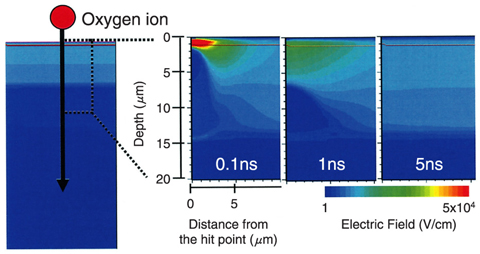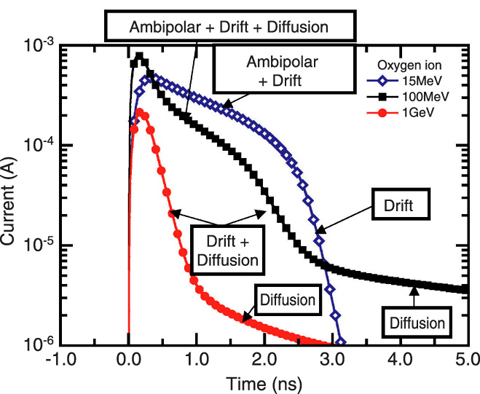Fig.4-27 Measured (a) and calculated (b) SET currents

Fig.4-28 Cross sectional images indicating the transient electric field after a 100 MeV O ion hits

Fig.4-29 Simulated transient current caused by O ions with energies of 15 MeV, 100 MeV, and 1 GeV
Electronic devices in space suffer from several long-term and short-term problems due to the high radiation levels. One such problem occurs when high energy heavy ions in Galactic Cosmic Rays (GCR) pass through sensitive portions of devices, where the electron-hole (e-h) pairs generated by the ion's energy loss can result in Single Event Transients (SET) that generate device damage or erroneous operation. In this study, to clarify the mechanism of GCR effect on carrier transport in junction diodes, the SET current induced by an ion was evaluated using a high bandwidth measurement system called Transient Ion Beam Induced Current (TIBIC) in conjunction with a 3 MV tandem and an AVF cyclotron accelerators. Fig.4-27 shows the measured SET currents resulting from Oxygen (O) ion with energies ranging from 6 to 100 MeV. In order to fully understand the carrier dynamics, we simulated the SET currents using the Synopsis TCAD. Since the ion initial track structure strongly affects SET current, the distributions of e-h pairs are calculated by considering the δ-electron production with MeV ion penetration and keV δ-electron transmission theory, instead of the cylindrical track structure generally accepted. As a result, the total collected charge obtained by time integration of SET current agrees well with the measured charge, errors being less than 10%.
Fig.4-28 shows two dimensional maps of the electric field after an O ion hits. We find that the electric field is instantaneously perturbed and the transient current is composed of ambipolar diffusion, drift, and diffusion currents. As shown in Fig.4-29 the contribution of these components to SET current waveform depends on the ion energy; that is, in the case of 15MeV O ions (1) the sum of ambipolar diffusion and drift currents and (2) only drift current, in the case of 100MeV (1) the sum of ambipolar diffusion, drift, and diffusion currents, (2) sum of drift and diffusion currents, and (3) only diffusion current. While energies used here are not high enough to simulate the energy spectrum of GCR, we predict the SET current due to GeV ions with the assistance of TCAD simulation. In contrast with 15 and 100MeV, in case of 1GeV, the ambipolar diffusion current does not flow any more, and the sum of drift and diffusion currents comprises the SET current waveform as shown in Fig.4-29.
By using TCAD simulations with carefully optimized models and parameters, the carrier dynamics and the energy dependence of SET current have been revealed. These results, together with further investigation, will aid future design of electronic devices intended for space applications.